Today, ARM officially released the Cortex-M7 processor, or specifically a microcontroller (MCU). Although there is only one letter difference, it and the Cortex-A series belong to two worlds, specifically a larger world.

The ARM Cortex-A family of processors is widely recognized as an application processor for high-performance mobile applications. Cortex-M and Cortex-R are the other two main products of ARM. They are all embedded. The former belongs to the microcontroller and the latter belongs to the real-time processor.
The biggest difference between Cortex-A and Cortex-M/R is that the latter two do not have a memory management unit (MMU). Its main task is to build a bridge between the processor and memory, perform physical address and virtual address translation, and Linux (Android), Windows, Mac OS X, iOS and other general purpose operating systems need it to work properly.
Cortex-M/R is paired with a real-time operating system (RTOS).

Although inconspicuous, although very low-key, the Cortex-M series is actually much more powerful than the Cortex-A series, regardless of the scale of shipment or the scope of application, Cortex-A often needs their cooperation to build a complete platform.
In fact, there are a lot of electronic devices in your side, and often there are many Cortex-M chips on many devices, but you haven't noticed it. From small thermostats, smart watches, power management units, to cars and satellites, they are all inside.
Nokia Microsoft Lumia Glance Screen, SensorCore, Motorola Moto Voice, Moto Display, Apple iPhone M coprocessor, behind the implementation of these technologies, the contribution is not the application processor, it is precisely the MCU.
The Cortex-M series was born in 2004, the first generation is called Cortex-M3. So far, Cortex-M processor shipments have reached 8 billion, more than the sum of all other ARM processors! Last year, the figure reached 2.9 billion, and in the first half of this year, there were 1.7 billion, and the speed is getting faster.
The number of Cortex-M authorized companies has also increased to 175.

[Cortex-M7 architecture analysis]
Although very small, the M7's primary mission is high performance, which claims to have reached an unprecedented level, while maintaining the ultra-small area and ultra-low power consumption of the series.
The reason why ARM strives to improve performance, ARM hopes to further open the grade with the traditional 8/16-bit products (M7 32-bit), and the second is to meet the next possible explosion point: Internet of Things (IoT), wearable devices, special After enhancing DSP processing power, the M7 is more suitable as an audio and visual sensing center than ever before.
Of course, for traditional industrial control, automotive and other applications, it is also like a duck.

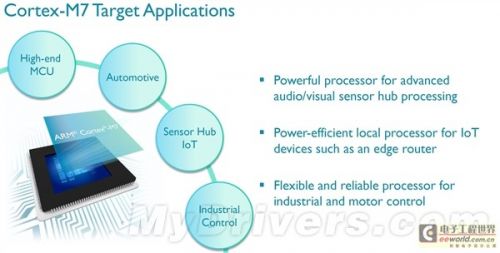
Architecturally, the M7 features a six-stage, sequential, dual-emission superscalar pipeline with single-precision, double-precision floating-point units, instruction and data buffering, branch prediction, SIMD support, and tightly coupled memory (TCM).
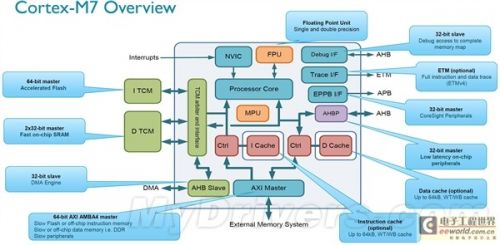
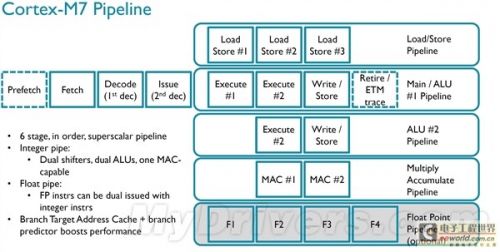
Command and data caching, branch prediction, and TCM are all not available in the previous M series. MCUs often don't consider caching, and sometimes even use flash as the only memory interface. By adding high-performance instruction and data caches (up to 64KB), M7 is beginning to move closer to typical high-performance processor designs.
TCM has only existed on the A and R series before, and can be used to extend the effective cache of M7, with a maximum capacity of 16MB, which is part of the MCU physical memory map.
It can have the performance of a real cache, but its content is directly controlled by the developer, can place some key code and data for access, interrupt service requests, etc., and the performance is very high.
The addition of branch prediction allows the M7 to be used for independent DSP services. When the code runs on an MCU that is always on, it almost always loops. Without a branch predictor, the code must constantly evaluate the loop status, but 99.9% of the results are the same path. Of course, the branch predictor consumes some core area, but it is worthwhile for DSP applications.

Because ARM Cortex processors are only selling licenses, the specific products depend on the implementation of the partners, so there is no way to discuss the area, power consumption, performance and other indicators, and there is no way to estimate.
The only thing AMD mentioned is that the energy consumption is the same as before, so given the theoretical performance increase of 50-70%, power consumption will pay such a large price.

Cortex-M series instruction set

Cortex-M series area, performance, power consumption
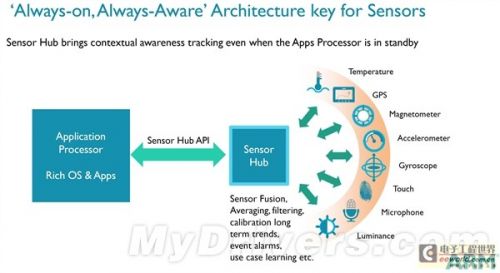
[M+A double sword combination]
The two series of M and A are often coexisting and cooperating. The former is often regarded as a coprocessor. ARM thinks that the A series is a coprocessor, because the MCU will always be online, and the application processor is not necessarily.
According to this, ARM has divided the wearable system architecture into three grades. The most basic one is MCU, and there is no application processor such as A series, such as wristbands and simple watches.
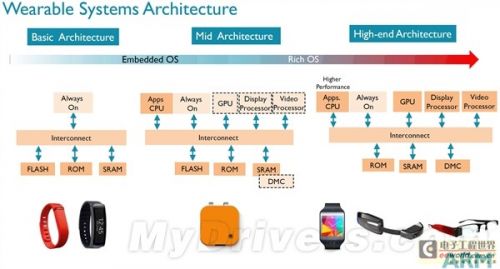
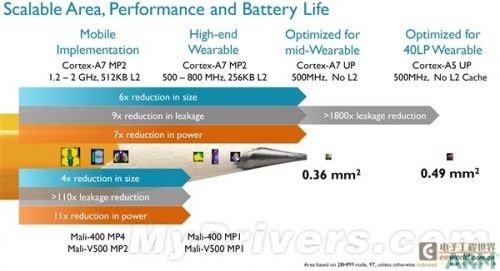
This is actually about how to design IoT, the wearable device platform. You need to choose the most appropriate architecture, platform, and weigh the performance and power consumption to see what you need.
Because of the rise, there are not many platforms dedicated to IoT and wearable. Many products have directly used traditional platforms. The problems are naturally many, especially the poor battery life.
For example, A15, ARM's proposal is to run at around 1.2GHz frequency, but in order to pursue high performance, many manufacturers have chosen to pressurize the frequency, and the power consumption naturally goes up. Similarly, if you put this platform in a wearable device, there is no guarantee of endurance.
Even Apple's Apple Watch can only last for one day, but its processor S1 is still relatively mysterious, and I am looking forward to how it is designed.
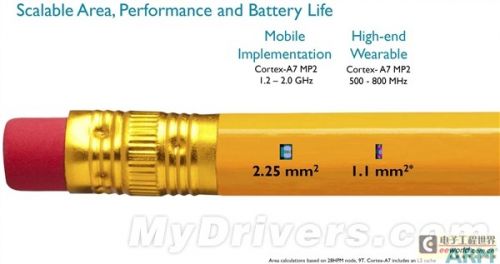
In this regard, ARM also put forward a series of recommendations to guide chip manufacturers how to reuse A7, A5, optimized design for wearable devices, especially cut the core area and frequency by at least half.
ARM also recommends that software-optimized delivery of specific tasks to the MCU can reduce platform power consumption by up to 85%. Look, in the end, encourage everyone to use Cortex-M.
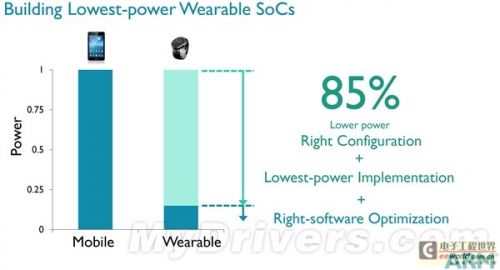
[Conclusion]
The Cortex-M7 takes the performance of the MCU to a new level and further incorporates the role of the DSP into a single 32-bit ARM instruction set CPU. The rich performance and functions allow device manufacturers to rely more on MCUs, and application processors are used sparingly, which can naturally improve overall power consumption and even make products that were previously unimaginable.
ARM also improved the M7's interrupt latency and provided some security standard certification kits, including ISO 26262 (automotive) and IEC 61508. Friends who have experience in this area will know how expensive such kits are.
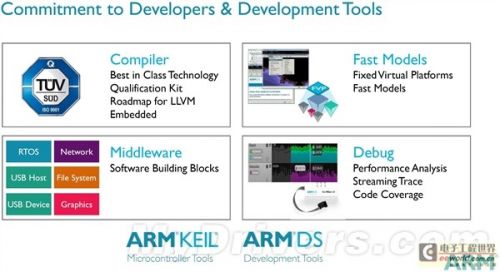
Atmel, Freescale and STMicroelectronics among the major MCU chip manufacturers have already purchased the Cortex-M7 license, and NXP and Texas Instruments believe that they will soon follow.
Future wearables will definitely be more exciting.

The Digit LED Display is one type of display screen. By inputting relative current to its different pins, it will light up, so as to display all the parameters that can be represented by numbers, such as time, date, temperature, etc.
Because of its low price and simple use, it is widely used in electrical appliances, especially in the field of household appliances, such as air conditioners, water heaters, refrigerators, etc. Most water heaters use Digit LED Display, and other household appliances also use LCD and fluorescent screens.
led display,different color ,wide usage ,High intensity and reliability
Wuxi Ark Technology Electronic Co.,Ltd. , https://www.arkledcn.com